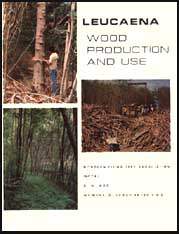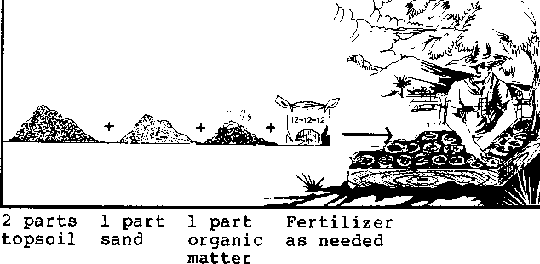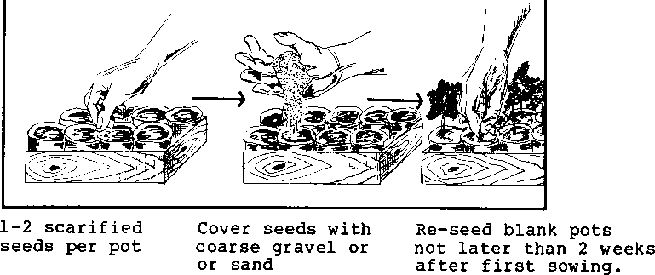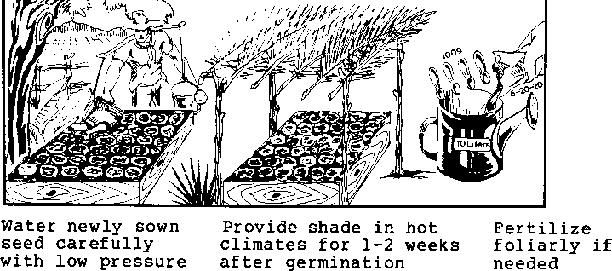Seedlings may be grown in a variety of ways and in a number of different containers. The decision to use seedlings must be made carefully, as either direct seeding or transplanting of seedlings have site specific advantages and disadvantages which must be considered (Section 5-2). Once it has been decided to plant seedlings rather than direct seed an area, the type of planting materials to be used must be determined. Leucaena is easily grown in containers, or in seedbeds from which they will be transplanted as stump cuttings or bare root seedlings.
The nursery operation for containerized seedlings should include a seedling bed or bench, a removable shade system, a reliable source of water, and a secure place to store materials and equipment. Benches or beds should be raised off the ground in container operations in order to permit air pruning of roots. It is most convenient for handling operations to raise the benches to waist height, however this requires substantial material inputs. Air pruning can be encouraged by raising the seedlings to a height of 20-40 cm above the ground. If this is not done, pots invariably become rooted into the soil, resulting in considerable expense and damage to seedlings when the seedlings are lifted out of the seedbed.
Shade is not a requirement for leucaena seedlings, but light shade is recommended for the first few weeks of seedling growth to slow drying of the potting media. Leucaena seedlings like full sunlight, and if grown under heavy shade will become spindly and less hardy than seedlings grown in full sunlight. A temporary or removable shading structure is convenient for the first few weeks of growth, and should be removed as soon as seedlings are well established.
4-2 CHOICE OF CONTAINERS
Leucaena seedlings are easily grown in almost any container, yet there are distinct advantages to selecting a readily available container which will produce high quality seedlings at the lowest possible cost.
Seedling quality is an important consideration in container selection due to the effects of container size and shape on the early growth of transplanted seedlings. The taproot of a leucaena seedling develops very rapidly during early growth and when given a large pot will either grow through the bottom of the container into the soil or will grow spirally in the bottom of the pot. Root development after transplanting may be severely inhibited if seedling roots have been broken following lifting of seedlings which have grown into the ground or if seedlings have a mat of roots which have grown spirally in bottom of the container. This is especially true for plantings on sites with low pH, poor soil fertility, low rainfall, or excessive weed competition.
There is no justification for the use of pots larger than 6 cm in diameter. In addition to the higher quality of seedlings produced in narrower containers (to a minimum of 2 cm), smaller containers have the advantage of lower costs for potting medium, transport, and transplanting because of reduced volume per pot.
Ideal containers for leucaena are the reusable polyurethane pots called dibble tubes (Figure 4-2), which are 2.5 cm in diameter and 15 cm in length. These tubes must be placed in specially designed flats made of hard plastic, styrofoam, wood or sheet metal. The tubes are tapered at the base, with ridges which run longitudinally to prevent root spiralling and a hole in the bottom to permit drainage and air pruning of roots. Alternative containers that are more commonly used are soft polyethylene bags (4-6cm x 1015 cm). The bags should be provided with holes in the bottom to allow drainage. Relative advantages and disadvantages of the two container systems are listed in Table 4-1.
Plastic bags are widely available and cost US -3 per thousand. Dibble tubes are manufactured in several countries and cost about US per thousand (but can be used 5-10 times). Further information about dibble tubes and suppliers may be obtained from the Taiwan Forest Research Institute (attn. TaWei Hu), 53 Nan Hai Road, Taipei, Taiwan or from the Hawaii State Division of Forestry (attn. Carl Masaki), 1151 Punchbowl Street, Honolulu, Hawaii, USA 96813.
Table 4-1 Relative advantages and disadvantages of dibble tube and plastic bag seedling containers
DIBBLE TUBE
|
Advantages |
Disadvantages |
|
|
|
|
|
|
|
|
|
|
|
|
|
PLASTIC BAGS
|
Advantages |
Disadvantages |
|
|
|
|
|
|
| |
|
|
|
greater water and nutrient holding capacity |
|
4-3 PREPARATION OF MEDIUM
Many media are suitable for growing leucaena in nurseries. A good medium is one that promotes seedling development, drains well, and has good nutrient and water holding capacity. A 1:1 mixture of peat and vermiculite has these qualities and is an excellent medium but is expensive and often difficult to obtain. Thus, where availability or cost rule out the use of this media, a media should be prepared that has as many of the superior qualities of this mixture as possible.
Native soil often provides a suitable base, if the pH is between 5.5 and 7.5. The texture of the potting medium is an important variable which can be manipulated through the addition of organic matter, sand, or other soil improving materials. Loamy, friable soil is best, but clayey soils may be used if screened and mixed with coarse sand or crushed gravel (2 parts soil, 1 part sand). Sandy or excessively drained soils might be improved by mixing in greater proportions of compost, manure or heavier topsoil. Topsoil should be obtained if possible from areas where leucaena is already growing (provided it is free of weed seeds) to provide locally adapted rhizobia (see Section 44). Organic matter should be added to enhance drainage and to provide nutrient and water retention. Suitable sources of organic matter include coconut coir, rice hulls, peat moss, crushed fern or bark, compost, and leaf litter.
A source of fertility is essential for good seedling development. Normally it is necessary to add cow dung, chicken manure, guano, compost, chemical fertilizer (12-12-12 preferred) or similar substance. Fertilizer requirements will vary with native soil fertility, however as a general rule chemical fertilizers should be mixed with the media at a rate of 2-4 heaping tablespoons per 20 liters of media. Organic fertilizers such as manure or compost should constitute approximately 20% of the total media if chemical fertilizer is unavailable. Foliar application of nutrients may be called for if deficiency symptoms appear.
4-4 RHIZOBIA
Leucaena is able to fix atmospheric nitrogen for use as a nutrient through the action of bacteria on the roots. Nodules on roots are the sites of N-fixation, and require very specific strains of bacteria. The strains of Rhizobium isolated from leucaena are fast growing and neutral or mildly acid-producing. In these respects, they are very different from most rhizobia of many other tropical legumes.
In most countries where leucaena is native or naturalized, it is nodulated well by native bacteria. In some areas, however, it fails to nodulate, resulting in extremely slow growth. Vigorous green growth occurs when nodulation is initiated.
In areas new to leucaena, trial plantings should be made to examine for the presence of nodulating bacteria. Established seedlings can be carefully uprooted and checked for the presence of nodules. If there is any doubt, inoculum containing suitable strains of rhizobia should be obtained from laboratories producing strains which specifically nodulate leucaena. These preparations are usually supplied in peat, and must be kept refrigerated (7° C) until used. The inoculum is mixed with water to make a slurry which is then mixed with scarified seed just before planting. Alternatively, it may be stuck on the seed with preparations like methofas or gum arable, or mixed directly with potting medium.
Information on reliable sources of rhizobial inoculant for leucaena may be obtained from NiFTAL Project; P.O. Box "O"; Paia, Maui, Hawaii, 96779; USA, or Bharatiya Agro-Industries Foundation; attn: N. Hegde; Ramadhenu, Senapati Bapat Marg; Pune, 411061, India.
4-5 SOWING SEEDS
Scarified seeds should be sown directly on top of the medium, with one seed per pot if top quality seed are used and two seeds per container if germination is less than 70%. Overseeding should be avoided, as later thinning is timeconsuming and may disrupt root development. Seeds may also be pre-germinated on damp towels and then potted when the radicle just emerges. Seeds should not be pressed into the soil, but left on top and covered with a layer of coarse washed sand, crushed rock or gravel (3-5 mm thick) (Fig. 43). This provides excellent air exchange and water drainage, allows rapid emergence of cotyledons, and prevents dampingoff.
4-6 IRRIGATION AND FERTILIZATION
Seedlings should be kept moist and watered as needed. Watering schedules should be set, but kept flexible enough to account for weather changes. Seedlings may require two or more waterings on hot and clear days and none on rainy, cloudy days. Generally, however, a good soaking in the morning before the heat of the day is recommended.
Water requirements are a function of seedling age and pot size as well as the moisture holding characteristics of the media. Older seedlings require more water than young seedlings and larger containers can be watered less frequently than small containers. Irrigation equipment will vary with availability of materials and water supply, so it is a good plan to visit local forest nurseries for specific designs.
Fig. 4.3 Nursery practices for leucaena:
POTTING MEDIUM
SOWING SEEDS
WATERING AND CARE
Foliar fertilizer is often desirable particularity when small containers are used. This can be scheduled about 4 weeks after sowing, using a low nitrogen fertilizer (e.g., 5-20-20) in water (10g/liter), sprinkled over the seedlings during regular watering.
4-7 PESTS AND DISEASES
Leucaena has few serious pests and these are rarely encountered in the nursery. Weeds may be a problem when seedlings are grown in a seedbed or when soil is used as a component in the potting media. Insect pests are usually minor, especially if seedling beds are raised, and can be controlled with low intensity chemical spray programs. Mealy bugs can be a serious problem, and can be controlled with systemic insecticides (e.g., Cygon).
There have been reports of seed purchased from certain locations having infections of fungal and bacterial pests. This may be avoided by purchasing disease-free seed from reputable sources. Disinfesting seed surfaces with a commercial compound such as Chlorox diluted 1:9 with water or with sulfuric acid during scarification procedures will generally control superficial diseases.
Fungal pests in the nursery are a problem if a gravel or rock layer is not applied, notably when the medium is soil-based. Damping off can be controlled by roguing, reducing watering, and applying a fungicide like Captan.
4-8 WHEN TO TRANSPLANT
Leucaena seedlings are ready for transplanting in 8-12 weeks, assuming the use of suitable pots and good growing conditions, longer if pots are too large or conditions less suitable. It is best not to transplant seedlings much beyond this age in most containers as root spiraling will occur in bag-grown seedlings. Stem elongation will be greater than in younger seedlings which increases the risk of dessication and die back upon transplanting. Once root spiraling occurs, little can be done but to transplant as soon as possible.
Stem pruning is normally not an acceptable practice with leucaena, and may induce forking. It should not be relied on to correct poor nursery practice, e.g., elongated seedlings caused by heavy shading. When seedlings are grown under full light, they are relatively dwarfed and woody, and survive transplanting exceedingly well.
4-9 SEEDLING TRANSPORT
The transport phase of nursery management involves removal of seedlings from the seedling bed, packing for shipment, and maintenance until planting. A thorough watering before transport will help avert losses due to drying.
Bagged seedlings should be lifted from the bed taking care to cut roots that may have grown into the soil below. The seedlings should be packed closely and not stacked prior to transport to the field. Dibble-tubed plants are removed from the tubes, packed laying horizontally in closed boxes (preferably with plastic liner). They can then be opened for aeration and watering if they are to be transported over long distances. Seedlings packed this way can survive for a week, but planting is recommended within 2 days of removal from the nursery. With care, such seedlings will lose few leaves when transplanted.
4-10 STUMP CUTTINGS AND BARE ROOT SEEDLINGS
Stump cuttings are seedlings which have been severely pruned, leaving only a short stump and a short piece of the main root. This is in contrast to bare root seedlings, which are seedlings from which soil has been removed. Stump cuttings and bare root seedlings can often be used in place of bagged seedlings and are lighter and much easier to handle. They can survive brief periods of drought after planting, but are less tolerant to drought and weed competition that bagged seedlings. One person can carry up to 600-700 stump cuttings or bare root seedlings from the nursery site to the planting site. Approximately twice as many stump cuttings per day can be planted than bare root seedlings.
Stump cuttings are produced by preparing a well-tilled, raised seedbed approximately 1 m in width. Beds are fertilized, watered, and sown thickly with scarified seeds (e.g., 30 x 10 cm). Seedlings are grown 4-5 months or until basal diameter averages 1 cm and height is over 1 meter. The bed is then thoroughly soaked, and the plants pulled out, leaving as much of the root attached as possible. The stems are then cut to about 10-20 cm above the root collar, and to 15-20 cm below.
Similarly, bare root seedlings are prepared by thickly sowing leucaena seed in a bed that can be flooded. Bunded rice paddies work well for this. Seedlings are allowed to grow for 2-3 months, until seedlings are at least 50 cm tall. The bed is then flooded and seedlings carefully pulled out. Roots and tops are left intact. Bare root seedlings should be transplanted as soon as possible.
Both bare root seedlings and stumps are packed in compact bundles and wrapped in moistened gunny or rice sacks. Root ends are puddled in the mud to protect them from drying and then wrapped. Rhizobia may be added to the mud if desired. Bundles should be kept damp during transport. Stump cuttings can survive several weeks if kept moist, although survival is improved by transplanting as soon as possible after preparation.



